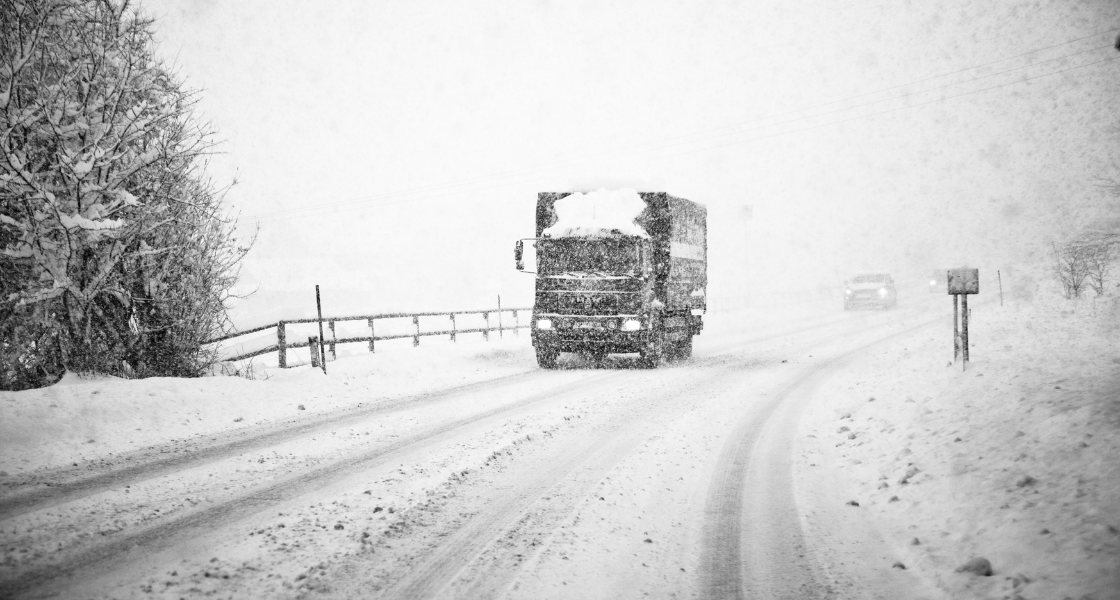Driving in bad weather can be a source of anxiety for many drivers.
Whether it’s rain, snow, sleet, or fog, extreme weather events lead to dangerous roads and, implicitly, more crashes.
If staying at home is not an option, it’s critical to adequately prepare to ensure the safest drive possible.
While it’s not possible to completely eliminate the risk of driving in inclement weather, by properly preparing and driving as safely and consciously as possible, you can reduce this risk.
Table of Contents
ToggleTip 1: Regular Vehicle Maintenance Crucial for Driving in Bad Weather

A major step before you embark on the road in bad weather patterns is keeping your vehicle in peak condition.
Part of this maintenance has to be done long before you ever take to the road. Investing in quality windshield wipers, having a functional spare tire, and maintaining tire tread and your car’s lights all have to be done regularly and before any weather events begin to form.
Additionally, perform a brief vehicle inspection before hitting the road. Key things to check include your car’s fluids, battery power, tire pressure, and fuel levels. Also, make sure your mirrors and lights are clean.
By simultaneously taking good care of your car ahead of time and inspecting it before each journey, the chance of your car having roadside issues or taking unnecessary damage due to an extreme weather event will dwindle.
Tip 2: Snow Tires Improve Road Safety in Cold Weather
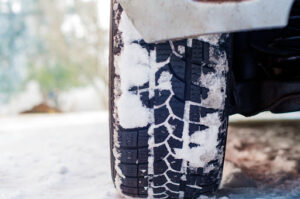
Another way to prepare your car for extreme weather events is by using snow or winter tires.
Unlike the all-season tires, winter tires are specially designed for extreme weather events during cold, snowy seasons. These tires are designed to be more flexible and to push snow out from under them, displacing snow and slush and reducing the risk of hydroplaning.
These combined attributes make winter tires crucial for safer driving during cold weather, minimizing skidding, sliding, and loss of control. In fact, they even allow vehicles without all or four-wheel drive to travel on thick snow blankets.
Tip 3: Visibility is Crucial for Road Safety
Any time you’re driving, but most especially during extreme weather events, visibility is key.
Without a clear grasp of the road, the cars around you, and your surroundings, driving can become extremely dangerous. If you’ve ever tried to imagine driving your car blindfolded, you can imagine the danger of driving without good visibility.
One aspect often overlooked is making one’s car as visible as possible to other drivers. The best way to improve your vehicle’s visibility is to run your car with low headlight beams as opposed to high or no headlights. Running with low beams reduces the number of accidents in bad weather by up to 38%.
You can also run your car with its hazard lights on in the most extreme conditions (depending on the state, as some outlaw driving with them on). This will make your car visible to those around you but should be reserved for only the most severe conditions. (Source: ajc.com)
Tip 4: Keep a Safe Distance From Other Vehicles During Poor Weather
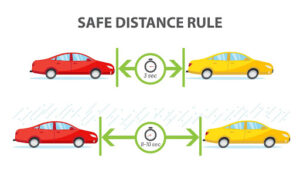
Increasing your following distance during poor weather significantly reduces the risk of accidents and collisions.
Rain, snow, sleet, or fog greatly impact visibility and road traction, making it harder to react to sudden changes in traffic. In fact, the braking distance required for your car to come to a complete stop doubles in rainy conditions and can quadruple in snowy weather.
To account for this change, it’s wise to increase your following distance to about 8-10+ seconds behind the car in front of you. An increased following distance provides a buffer, allowing you to brake gradually and avoid abrupt stops that could lead to skidding.
By giving yourself extra space, you create a cushion that gives you a better chance to react to unexpected situations, mitigating the chances of rear-end collisions and promoting a safer driving experience for everyone on the road.
Tip 5: Calm Driving Improves Road Traffic Safety During Extreme Weather Events
Driving with heightened caution and unwavering awareness emerges as the most effective strategy for ensuring safety during extreme weather conditions.
Whether facing the fury of a blizzard, the deluge of pouring rain, or the obscuring veil of thick fog, adapting your driving behavior is paramount. Slower speeds, increased following distances, and a gentler touch on the gas and brake pedals become essential components of your defensive driving arsenal.
Remaining acutely attuned to your surroundings, anticipating potential hazards, and maintaining a vigilant eye on the movements of other vehicles empower you to respond promptly and decisively to unforeseen challenges.
Tip 6: Route Planning is Crucial for Driving in Poor Weather
Proper route planning is a great way to make your drive safer by choosing the best route, reducing stress, and preparing for poor weather. This can be a game changer when unexpected weather events can slow down trips and cause you to run late. Knowing what lies ahead allows you to mentally prepare for the conditions you might encounter, helping to maintain focus and composure.
Tip 7: Nitrogen Tires Enhance Safety in Extreme Weather
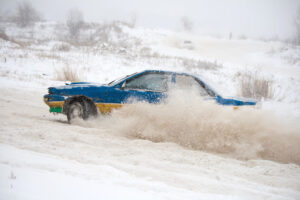
Nitrogen tires are a valuable enhancement to your vehicle in extreme conditions.
Due to its unique molecular composition and traits, nitrogen gas seeps out of your tire more slowly than compressed air and is not as affected by temperature drops. Air tire pressure can fluctuate significantly on cold or hot days, as the gas expands and contracts, creating an inconsistent tire pressure when traveling through extreme weather.
However, with nitrogen tires, the nitrogen gas filling the tire does not react as much as air to the temperature around it. For this reason, nitrogen tires are favored for airplanes and high performance vehicles, where temperature changes are common. This reduced variance in tire pressure enhances the performance of nitrogen tires, keeping them at the ideal pressure and enhancing safety.
Tip 8: Regular Driving Practice Improves Your Response to Extreme Weather
Getting plenty of practice behind the wheel in various conditions can build confidence and skill for handling tough weather situations.
When you’re practicing regularly, you get a chance to handle hydroplaning on wet roads and those unexpected skids on icy patches. It’s like building up your driving resume. You learn how your car responds when things get slippery and how to react to regain control.
Practicing these scenarios in a safe setting helps you get the hang of it, so when it happens on the road, you’re not caught off guard. By simulating hydroplaning and skidding situations, drivers develop an innate understanding of how to regain control, steer out of a skid, and modulate their brakes and accelerator to prevent further loss of control.
This invaluable practice translates to increased confidence and better decision-making when navigating the unpredictable landscapes of inclement weather, ultimately promoting safer driving for both the driver and others sharing the road.
Tip 9: Avoid Driving During Severe Weather (if Possible)
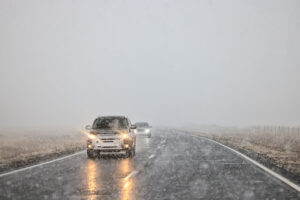
Driving in extreme weather conditions presents numerous hazards and risks that make it advisable to avoid such situations whenever possible.
First and foremost, safety is of great concern. Extreme weather, whether it’s heavy rain, snowstorms, icy conditions, or strong winds, can severely impair visibility and road traction, significantly increasing the chances of accidents, collisions, and loss of control over the vehicle. Reduced visibility and slippery road surfaces make it difficult to predict and react to potential hazards on the road.
Second, driving in extreme weather also poses a variety of practical issues. Your vehicle may experience mechanical breakdowns or tire punctures due to harsh conditions, leaving you stranded in dangerous circumstances. Furthermore, extreme weather can cause road closures, traffic congestion, and long delays, impacting travel plans and increasing frustration.
Given these factors, it is best to avoid driving in extreme weather conditions whenever feasible. But if you must drive then it’s wise not to force anything. If you’re feeling tired or under the weather at all, the safest option is to pull over and rest or wait for the weather to improve. But even if you consider yourself the most expert driver, the potential dangers associated with extreme weather make staying off the road whenever possible the safer, more responsible choice.
Make the Switch to Nitrogen for Enhanced Road Safety!
At Fuel and Tire Saver, we offer a nitrogen tire inflation service as a cost-effective solution for optimizing tire performance!
Our team is committed to the science behind nitrogen tire inflation and can work with you to develop a customized tire maintenance plan that meets the unique needs of your fleet.
Contact Fuel and Tire Saver and check out our resources page to learn more about our nitrogen-filled tires and how we can help keep your fleet rolling smoothly!
References
- “Safe Driving in Bad Weather Conditions.” Arrive Alive, 27 July 2023, www.arrivealive.mobi/safe-driving-in-bad-weather-conditions. Access date: 15 August 2023.
- Stueber, Scott. “Winter Tires Offer Huge Benefits.” West Bend Insurance of Wisconsin, 29 June 2022, www.thesilverlining.com/westbendcares/blog/winter-tires-offer-huge-benefits. Access date: 15 August 2023.
- “Top 10 Safety Tips for Driving in Bad Weather.” Mayor Law, 21 May 2019, www.mayorlaw.com/top-10-tips-driving-safely-bad-weather-conditions/. Access date: 15 August 2023.
- Webb, Kristina. “Using Hazard Lights in Rain Is Illegal in Some States; Use Could Cost You.” Ajc, 30 Aug. 2016, www.ajc.com/news/national/using-hazard-lights-rain-illegal-some-states-use-could-cost-you/4GKuiHXYiiowRgq5CgPjLP/#. Access date: 15 August 2023.

